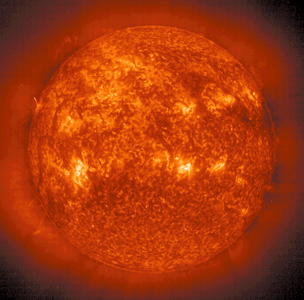March 8-14, 2012, Current Events Lesson Plan
Current Event:
A massive wave of radiation from the sun–the most intense since 2006–walloped Earth recently. This ball of plasma and charged particles is called a coronal mass ejection (CME). It originated in a monster solar flare that erupted from the surface of the sun. CME’s have the potential to seriously disrupt radio and satellite communications, including GPS signals, airline communications, and electric power transmission.

The sun is a star with a diameter of approximately 864,000 miles (1,390,000 kilometers), about 109 times the diameter of Earth. Photo courtesy NASA/NSSDC
Objective:
Coronal mass ejections are the strongest type of solar eruptions, releasing enough energy to supply all of Earth’s commercial energy needs for more than 12,000 years. The Behind the Headlines news story and related World Book articles explain this phenomenon, and how it affects people on Earth.
Vocabulary Terms:
- coronal mass ejection
- eruption
- magnetic field
- magnetic storm
- particles
- plasma
- radiation
- satellites
- solar flare
Discussion Topics:
1. The sun is a huge, glowing ball at the center of our solar system. The solar system’s planets and their moons, millions of asteroids, and trillions of comets revolve around the sun. What else do your students know about the sun? (They may say it’s entirely made up of gas, it’s one of hundreds of billions of stars in the Milky Way Galaxy, it’s about 25,000 light-years from the center of the galaxy, or that the part of the sun that we see has a temperature of about 5500°C (10,000°F).)
2. The sun, like Earth, is magnetic. Scientists describe the magnetism of an object in terms of a magnetic field. This is a region that includes all the space occupied by the object and much of the surrounding space. The sun’s magnetic field becomes highly concentrated in small regions, with strengths up to 3,000 times as great as the typical strength. These regions shape solar matter to create a variety of features on the sun’s surface and in its atmosphere, the part that we can see. What kinds of features could one find on the sun’s surface? (Some answers include relatively cool, dark structures known as sunspots to spectacular eruptions called flares and coronal mass ejections.)
3. The ball of plasma and charged particles that recently caused a major magnetic storm may also produce displays of the northern lights much farther south than normal. Discuss the northern lights and where they’re usually seen. (The northern lights are an auroral display usually limited to Earth’s polar regions.)


